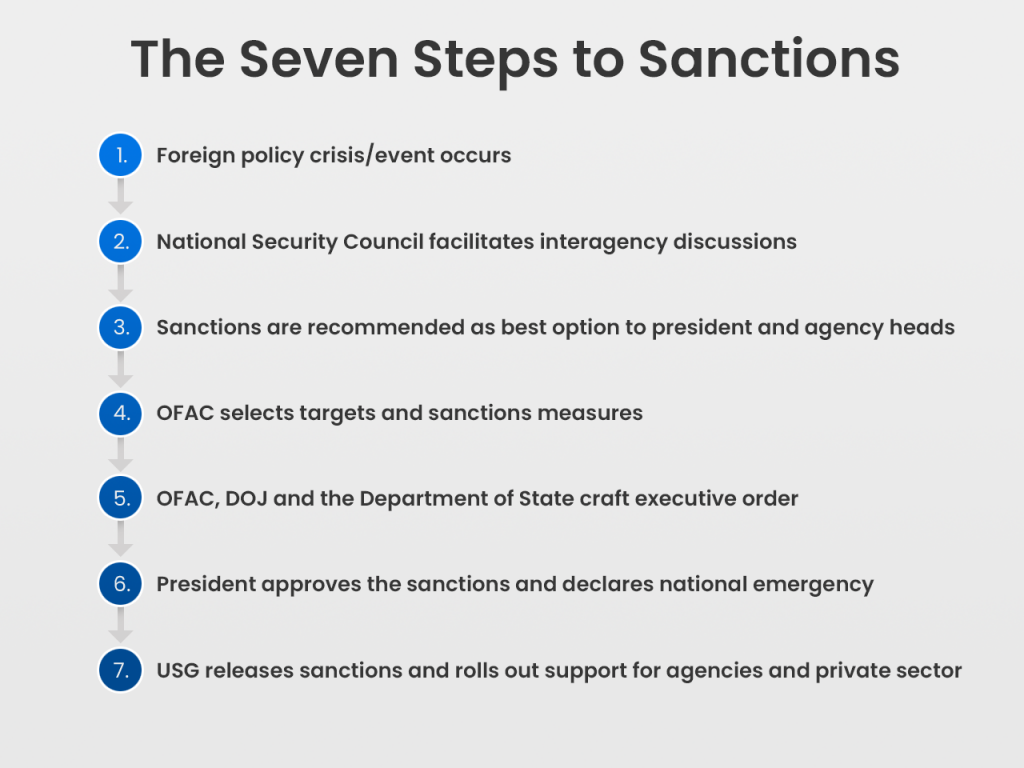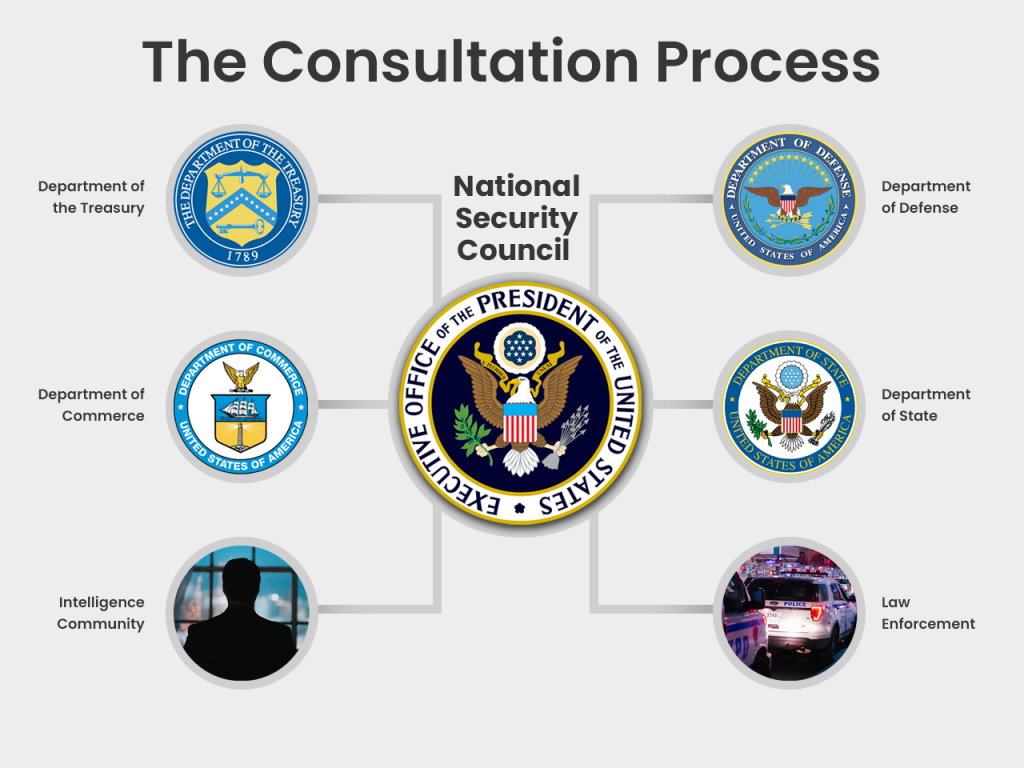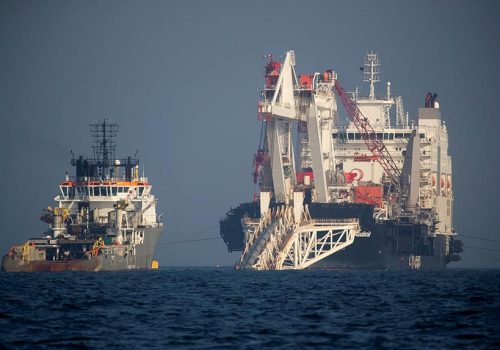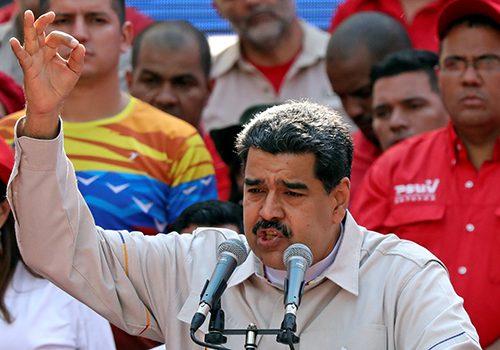Sanctions explained: How a foreign policy problem becomes a sanctions program
Atlantic Council experts detail the complex route policy makers follow to develop and deploy sanctions
Why Sanctions?
The Trump administration, like its predecessors, has faced a range of foreign policy and national security challenges, and in nearly all of them it has turned to economic and financial sanctions, from regional security and proliferation threats in Iran and North Korea to destabilizing violence in Mali. Why would this tool, relatively infrequently used prior to the administration of President George W. Bush, now be the default response to so many foreign problems?
Simply, sanctions allow a US president to exercise power unilaterally and often expeditiously. They are often one of the few middle grounds between war and words. Sanctions can be deployed absent input from the Congress and without conducting sensitive and time-consuming diplomatic relations or risking the loss of life from military action. They are best deployed in concert with others, of course; in many instances sanctions are the product of thoughtful multilateral policy, such as the ramp-up of sanctions on North Korea in the early months of the Trump administration. But the power afforded the US president under the International Emergency Economic Powers Act of 1977 (IEEPA)—the legal authority upon which most sanctions programs are built—is extraordinarily broad and relatively unconstrained, allowing for seemingly quick unilateral responses to international issues of concern.

The toolkit
US administrations have a broad toolkit of measures with which to address foreign policy and national security challenges: diplomatic engagement, military response, economic support, legal assistance, and economic and financial sanctions, among others. An administration may choose specific tools for an array of different reasons. A military response may unnecessarily escalate a foreign policy problem or may be too risky to support. Diplomatic engagement may have already failed or be unlikely to garner timely results. Sanctions offer a coercive tool that sends a strong message and can have a significant impact when applied appropriately and effectively.
Once a threat is identified—e.g., Nicolas Maduro’s undermining of democracy in Venezuela—the US National Security Council (NSC) convenes experts from across the relevant executive branch agencies (the ‘interagency’) to discuss the severity of the threat and possible options. In these sensitive discussions, analyses and options are often presented by the Commerce, Defense, State, and Treasury Departments as well as the Law Enforcement and Intelligence Community. Recommendations are then drafted and presented up the chain to senior level officials in those agencies and then to the president for a decision on the policy direction that the United States will pursue.

The exercise of powers granted to the president under IEEPA—the underlying legal authority for most sanctions programs—requires a declaration of national emergency with respect to a threat to the foreign policy, national security, or the economy of the United States that emanates largely from abroad. IEEPA affords the US president the ability to regulate commerce, including through imposing sanctions, once the national emergency in declared. Generally, that threat is identified well before policy makers decide on sanctions as a preferred course of action, though there are certainly exceptions. For example, political violence and repression in Venezuela was happening long before sanctions were imposed on the Maduro regime, as compared with sanctions in response to the Gaddafi regime’s violent suppression of Libyan protests in 2011 that were designed and deployed within seventy-two hours.
When considering a new sanctions program, one key consideration is how allies view the foreign policy problem under discussion. Since sanctions are most effective when implemented multilaterally, interagency deliberations often factor in if allies may support—or ideally join in on—the sanctions effort. Coordination with allies can slow the sanctions process, but is often well worth the time and effort necessary for effective coordination since multilateral sanctions are more effective than those imposed unilaterally.
Can Congress initiate sanctions?
Yes, Congress has the authority to introduce new sanctions programs through legislation and to codify or build on existing sanctions programs that are introduced by the executive branch. While Congress has introduced stand-along sanctions legislation, such as the Sergei Magnitsky Rule of Law Accountability Act and the Foreign Narcotics Kingpin Designation Act, it is more common for Congress to pass sanctions-related legislation that is complimented and strengthened through a subsequent executive order issued by the President, as in the case of the Global Magnitsky Human Rights Accountability Act and Executive Order 13818.
Identifying points of leverage
Once the interagency has agreed that sanctions will be used to address a foreign policy crisis, the details must be addressed before the sanctions program can become public. For sanctions to be effective, they need to seek a change in behavior either by targeting bad actors and/or by dissuading those who would otherwise undertake malign actions. Targets with US assets or a nexus to the US financial system provide points of leverage that magnify the impact of sanctions and ensure the tool is impactful. For example, in the case of Global Magnitsky sanctions applied to corrupt businessman Dan Gertler, much of Gertler’s hundreds of millions of dollars in assets are blocked (or frozen) as a result of the sanctions on him and his network. Such targets therefore need to be carefully selected to ensure that the policy objectives of a sanctions regime are met and the impact of the sanctions will be thoughtfully calibrated. This can be tricky. It takes extensive research and deep knowledge to pinpoint the critical financial linkages and supporters of a terrorist network like al-Qaeda, or to target sanctions on major Russian financial institutions so there is impact without spillover to the global economy in which they are so well integrated.
Regardless of the complexity in identifying sanctions targets, the career professionals across the US government are critically important to this process. Senior level policy makers set an expectation of policy direction and desired impact, but the technical pros’ deep expertise and knowledge drives the majority of the target selection within those boundaries and are an indispensable part of successfully executing policy. Senior government leaders set strategic direction, but they don’t know which front companies North Korea is using to source nuclear program components that would make impactful sanctions targets.
Crafting an authority
Once the policy scope has been determined and the initial targets chosen, the attorneys assigned with Treasury’s Office of Foreign Assets Control (OFAC) go to work drafting a sanctions executive order (EO) that fits the desired policy impact and is broad enough to go after both initial and future targets. This requires selecting designation criteria specific to the individual foreign policy problem, such as being senior officials of a malign government—as in the case of Syria—or to have undermined democratic processes or institutions—as in the case of Belarus. Typically, the draft EO will delegate the powers under IEEPA to the secretary of the Treasury to execute, in consultation with the secretary of State (very occasionally in reverse order). Internal to the Treasury Department, the secretary re-delegates that same authority to the director of OFAC, who formally signs off on the sanctions actions.

The draft executive order is then coordinated with the State Department’s legal team and the Department of Justice (DOJ) to ensure that all the legal boxes are checked. Those two agencies are particularly relevant because secretary of State’s consultative role in nearly all sanctions programs, and because DOJ is the agency that defends any legal challenges to executive branch actions, including sanctions. Those lawyers all work with the White House attorneys to ensure that an executive order is within the scope of the powers authorized under IEEPA and defensible to legal challenges.
Releasing the authority
After all the work that goes into planning a new sanctions regime, the NSC packages up the EO, the initial targets, and the formal policy decision and presents it to the president for final approval and signature. Alongside the signed EO, the president may designate targets in an annex to the executive order, as was the case in 2011 with the designation of Gaddafi and many of his children accompanying the issuance of EO 13566. Concurrent to the issuance of the executive order, OFAC may also designate targets under the delegated authority as happened in January 2019 with Executive Order 13850 imposing sanctions on Venezuela. Generally, new EOs are accompanied by sanctions designations to magnify the impact and illustrate the behavior of concern.
Licensing
A key aspect of effective sanctions implementation is calibrating the sanctions through licensing. IEEPA affords OFAC to authority to issue both general and specific licenses to authorize otherwise prohibited transactions or other specified activity with designated individuals or entities. A general license authorizes a particular type of transaction/activity for which those who meet the terms of the general license need not apply to OFAC for further authorization. A specific license is provided in response to a written license application and authorizes specified activity solely for the individuals/entities named in the specific license provided the conditions of that specific license are met. Licenses are a key tool to mitigate unintended consequences of sanctions and to recalibrate blunt sanctions without terminating the framework of a sanctions program.
Simultaneous with the issuance of most new sanctions executive orders, OFAC will often also issue frequently asked questions (FAQs) or other guidance that gives direction to the private sector that is charged with adhering to the scope of sanctions. OFAC may also issue general licenses to delay the impact of sanctions, such as those granting a wind-down period to cease prohibited transactions when the Trump administration released an executive order re-imposing sanctions lifted under the Iran Deal, or to carve out some impact of the sanctions imposed.
These more technical actions are typically accompanied by a messaging campaign helmed by the NSC/White House. Strategic messaging seeks to articulate the US foreign policy reasons for the imposition of sanctions and an explanation of the behavior change or other outcome that the US expects as a result of the sanctions or broader policy effort.
Brian O’Toole is a nonresident senior fellow with the Atlantic Council’s Global Business and Economics Program. He is a former senior adviser to the director of the Office of Foreign Assets Control (OFAC) at the US Department of the Treasury. Follow him on Twitter @brianoftoole.
Samantha Sultoon is a visiting senior fellow with the Atlantic Council’s Global Business and Economics Program and the Scowcroft Center for Strategy and Security. She is a former sanctions policy expert for the Department of the Treasury’s Office of Foreign Assets Control (OFAC).
The views expressed are those of the authors and do not purport to reflect the official policy or views of the Department of the Treasury or the U.S. Government
Read more on US sanctions policy
Image: Former Office of Foreign Assets Control (OFAC) Director Adam Szubin and his staff meet at the U.S. Treasury Department in Washington March 26, 2014. REUTERS/Gary Cameron


